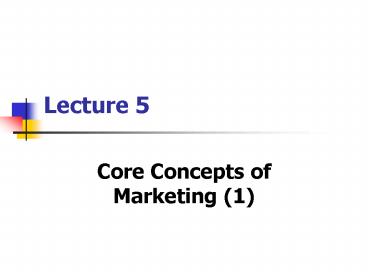Core Concepts of Marketing 1 PowerPoint PPT Presentation
1 / 36
Title: Core Concepts of Marketing 1
1
Lecture 5
- Core Concepts of Marketing (1)
2
Marketing
- Marketing is the process of planning
implementing the conception, pricing, promotion,
and distribution of ideas, goods, services to
create exchanges that satisfy individual
organizational objectives
3
Marketing environment
- Microenvironment (internal)
- Macroenvironment (external)
4
Microenvironment(Internal environment)
- Marketing managers work co-ordinate marketing
activities with other department within the
mission, objectives, strategies polices.
5
Microenvironment(Internal environment)
- Suppliers who provided resources needed by the
company to produce goods services - Aware of supply shortages, labour strikes, can
interfere the suppliers, cause lost of sales,
create customer dissatisfaction
6
Microenvironment(Internal environment)
- Marketing intermediaries aid company in
promoting, selling, distributing goods to final
buyers - Include middlemen, physical distribution firms,
marketing service agencies, financial
intermediaries - Retailers wholesalers
7
Microenvironment(Internal environment)
- Customer one or more of five different markets
- - consumer markets consumers buy products for
personal use - - industrial markets companies buy products to
produce other products - - reseller markets
- - government markets
- - international markets
8
Microenvironment(Internal environment)
- To be successful, you must satisfy the needs
wants of consumers better than your competitors
do - A public can have an impact on organizations
ability to achieve its objectives - A public may be financial, media, government,
citizen action, local or internal in nature
9
Macroenvironment (External environment)
- Demographic environment
- Economic environment
- Natural environment
- Technological environment
- Political/Legal environment
- Cultural environment
10
Demographic environment
- Characteristics of human population
- Important trend ageing of population, decrease
in birth rate, increases in life expectancy,
increase education level, demand for quality
products - Affect targeting strategies
11
Economic environment
- Peoples buying power is a function of income,
prices, savings credit - Inflation reduces purchasing power
- Interest rates, recession, and recovery have an
impact on consumer spending - Consumer spending patterns affect marketers
product offerings, pricing, promotional
strategies
12
Natural environment
- Natural resources is limited
- Increase cost of energy
- Increase levels of pollution
- Increase awareness of environmental protection
13
Technological environment
- Change so quickly in some industries, biological
science (DNA identification), medical,
communication system - Products/services become obsolete very quickly
and replace by new products/services (Web-based
shopping, E-commerce, M-commerce)
14
Political/Legal environment
- Made up of laws, government agencies pressure
groups - Try to maintain favorable condition both foreign
and domestic - To gain public support
- i.e.tobacco, clear air
15
Social and Cultural environment
- Women entering the work force single-parent
families are increasing - Culture diversity affect basic value,
perception, preferences, religion behaviour - Long-lasting, from parents to children
- Affect buying behaviours
16
Marketing research process
- Define problem determine present situation
- Collect data
- Analyse the research data
- Choose the best ethical solutions
17
Consumer buying process
- Problem recognition
- Information seeking
- Evaluation of alternatives
- Purchase decision
- Post purchase evaluation
18
What influences consumer behaviour?
- Marketing mix (4Ps) product, price, promotion,
place - Sociocultural influences preference groups,
family, social class - Psychological influences perception, attitudes,
learning, motivation - Situation influences physical surrounding,
previous experience
19
Market Segmentation Major variables
- Geographic segmentation divide the market into
nations, states, regions, countries, cities or
neighbourhoods - Demographic segmentation age, sex, family size,
income
20
Market Segmentation
- Psychographic segmentation social class, life
style, personality characteristics - Behaviour segmentation knowledge, attitude,
use, response to a product - Other segments user status, buyer readiness
stage, loyalty status, attitude
21
Market Targeting
- Undifferentiated marketing
- Differentiated marketing
- Concentrated marketing
22
Undifferentiated marketing
- Ignore market segment differences
- Go after the whole market with one market offer
- Develop a product aimed at the broadest segment
of the market
23
Differentiated marketing
- Operate in several segments of a market
- Design separate offer for each
- Could lead to higher sales than undifferentiated
marketing - Also increase promotion, inventory, other cost
24
Concentrated marketing
- Focus on a single market segment
- Go after a large share of one or a few
sub-markets - Increase risk consumer tastes may change or
competitors may enter the market - But if the segment is chosen served well, can
earn a high rate of return on investment
25
Market Positioning
- Once decided which segments to enter, the next is
to decide what positions the company wants to
occupy in those segment - Products position the place the product
occupies in consumers minds relative to
competing products
26
Marketing Mix (4 Ps)
- Product
- Price
- Promotion
- Place
27
Products
- Any physical good, service, or idea that
satisfied a want or need - Three levels of Product
- - core product
- - formal (actual) product
- - augmented product
28
Core Product
- All core benefits or services offered to
customers - E.g. the core benefit of a car convenience,
comfort
29
Formal product
- Five characteristic
- Quality level
- Features
- Styling
- Brand name
- packaging
30
Augmented product
- Total benefits perceived by customers
- Include installation, free delivery, warranty,
repair maintenance services
31
The Product Life Cycle
32
Introduction
- Market development
- Focus on making potential customers aware
- Slow sales growth
- Profits nonexistent
- Heavy expenses
33
Growth
- Rapid market acceptance
- Increase market share
- Substantial profit improvement
34
Maturity
- Achieved acceptance by most of potential buyers
- Slowdown in sales growth
- Profits stabilize or decline
35
Decline
- Sales show a strong downward drift
- Profit erode
36
Product Development Process
- Product ideas
- Screening
- Concept testing
- Business analysis
- Prototype development
- Product testing test marketing
- Commercialization

